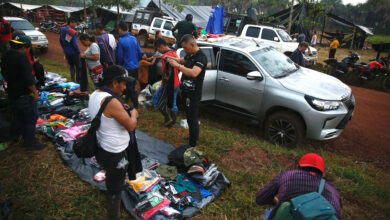The shredding of Peruvian society: Two months of ongoing crisis

By Paula Bayarte
Lima, Feb 7 (EFE).- Exactly two months ago, then-Peruvian President Pedro Castillo, with trembling hands and nervousness in his voice, tried to stage a self-coup that failed but served to remove the lid from a Pandora’s box of trouble, including violent protests and the ghosts of the past which have plunged the country into a crisis on all levels and without any clear way out.
Almost 70 dead, hundreds of people injured and huge anti-government marches in various parts of the country have not been enough to get the executive and legislative branches to agree to an early election, announce resignations, engage in self-criticism or launch a dialogue with the demonstrators to calm down the turmoil.
In fact, both government branches have dug in on their positions, risking a violent split within the country and making the frustration felt by a portion of the public even deeper.
The takeover of several airports, dislodging protesters from the Universidad Nacional Mayor de San Marcos in Lima with an armored car, the charred body of a police officer in Juliaca, the Puno region practically militarized and under-age protesters dead are just some of the dramatic events that have unfolded as security forces have fired thousands of tear gas canisters to try and disperse the massive numbers of protesters in the streets.
As if that were not enough, the accusation by some of the public, and even by the government, that the protesters are terrorists has opened the wounds of Peru’s recent bloody past.
“We’re not terrorists,” cry the relatives of the victims who have died in the protests in recent weeks and the demonstrators in the streets.
On Dec. 7, when then-Vice President Dina Boluarte assumed the presidency, she said that she would remain in that office until the end of the current presidential term in 2026, a statement that served to inflame the protesters around the country, especially in the south.
Castillo voters see how Boluarte, who has kept a low profile but tilts sharply to the left, began to suppress the early protests by force whereupon the demonstrators began to call her a “traitor” and a “usurper.”
Over time, those insults morphed into another harsher one: murderer.
When the death toll in the demonstrations surpassed 10, Boluarte changed her discourse and announced that she was heading a transition government. The situation has continued to escalate, even though the government presented a bill to Congress to move up the general elections.
And although the government didn’t seem like it was about to fall, the legislative branch also refused to deal with Boluarte. Over the past week, lawmakers rejected as many as four bills proposed by different parties that would have moved up the general elections.
One of the main demands made by the protesters – namely, that they want to quickly vote for new leaders who perhaps could defuse the situation – has been virtually derailed, given that a bill containing that kind of reform would have to be approved before Feb. 10, the date on which the current legislature ends its session.
That possibility appears to be out of the question after the ongoing episodes where Congress in recent weeks has demonstrated its disconnect with society and lawmakers have shown little political will to calm the heated passions.
The government message that has not changed is that of touting the “impeccable” and “glorious” actions of the National Police who, however, have shown in numerous instances their inability to maintain public order.
In all, 47 people have died in clashes with security forces. Ayacucho, Andahuaylas, Arequipa and Juliaca, where demonstrators burned the body of a police officer, and the streets of downtown Lima have all seen a huge police presence and repressive tactics that human rights organizations have called “indiscriminate” and with a clear “racist” component.
To that scenario must be added the fact that thousands of police officers marching through the streets in rhythm to their own parade chants have made the country’s cities seem like military barracks.
And criticism has multiplied with the indiscriminate attacks on the press, more than 150, according to the National Journalists Association (ANP), most of them committed by police.
To date, neither Boluarte nor Cabinet Chief Alberto Otarola, and certainly none of the top officials in the Interior and Defense Ministries, have publicly criticized the attacks that have become routine occurrences, despite insistent requests from the unions, who are demanding respect for the right to be informed about the situation.
There have also been attacks by the demonstrators on media workers trying to honestly report on the ongoing unrest.





